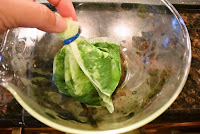<Ingredients >
Lots of spinach or any vivid green vegetable leaves (450 g spinach leaves used in photos below)
Generous pinch of salt
Water
<Directions>
1.
Chop up spinach, and puree with salt and enough water to maneuver (pureed with hand blender in photo).
2.
Strain through cloth into a pot.
3.
Remove solids, add enough water, and grind further with pestle.
Strain again.
Repeat grinding.
4.
Heat liquid on medium low heat.
When vivid dots start to appear, reduce heat to low, and continue heating
5.
Scoop the green substance from surface, and transfer to filter/cloth (teabag in photo).
6.
Close and tie filter/cloth, and soak in cold water for 60+ minutes to remove any bitterness and salt.
Change water a few times while soaking.

Squeeze out excess water.
<Notes>
- The amount of spinach (450 g) above yields about 2 tablespoons of aoyose.
- Spinach is the most common vegetable for aoyose in Japan. Komatsuna, daikon radish leaves and kabu turnip leaves are also commonly used. Any vivid green vegetable leaves, including parsley, are said to work.
- If again grinding solids after straining once is bothersome, you can stop right there and heat up the liquid. The combination of suribachi mortar and surikogi pestle usually grinds ingredients finer than a food processor or hand blender, and grinding with these tools ensures more chlorophyll goes into the pot.
- If you do not have a cloth to strain the pureed leaves, you could use a strainer as shown at right. The final paste from this works well too, except that the texture is a bit rougher.
- Ao, which usually means blue in modern Japanese, often refers to the color green when it comes to vegetation.
- Fuki no shiroppu-ni /candied Japanese butterbur
- Takenoko no kinomeae / bamboo shoot in sasho leaf miso dressing













No comments:
Post a Comment